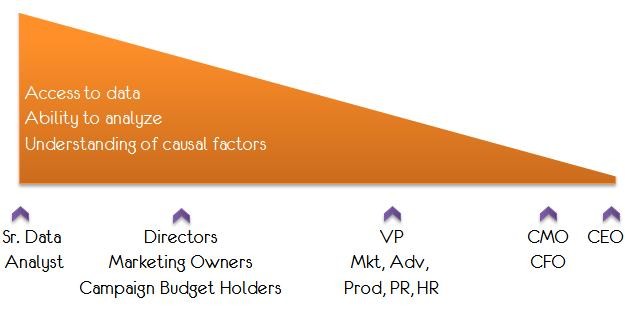
Product Management Predictions for 2026: The New User, New Metrics, and New Rules
Product management isn’t breaking. But many of the assumptions we’ve built it on are. These product management predictions for 2026

Every product team tries to prioritize features that most significantly drive sales and retention. Few however realize that reporting dashboards present exactly that opportunity and emphasize it accordingly. That’s because product teams are typically focused on end users while sales teams interface with actual buyers and decision makers. This ‘misalignment’ manifests most painfully when developing the critical feature of reporting.
Ultimately, the decision-maker for most B2B purchases isn’t actually the end user. It’s the manager who may never log in, but who will nevertheless evaluate whether the tool is helping their team achieve strategic goals.
According to a report of 500 product professionals, building advanced reporting features demonstrably increased win rates and user adoption. Unfortunately, the same report states that two-thirds of end users continuously switch “from business apps to separate analytics tools to get the data or analysis needed.” Further, virtually every department remains ineffective at accessing data to make informed decisions, despite leveraging countless software solutions. A veteran digital marketing evangelist from Google refers to this as an “asymmetry in analytical ability”, and created a nifty corresponding graphic:

To understand how this happens in practice, consider the following example which highlights the ramifications of inadequate dashboards in otherwise fabulous products.
You’re on the product team at a company that offers a recruiting platform, known in the industry as ‘applicant tracking software’ (ATS). Your sales director knows that the VP of Human Resources at a client is focused on filling key roles at a predictable pace in order to keep up with their organization’s rapid growth. They’ve purchased a 6-month pilot on your ATS, because their recruiting team loved the demo.
Great work! You read Clayton Christensen’s latest book, Competing Against Luck, and have rigorously applied the ‘jobs to be done’ framework to your product. You’ve spent the last year enabling recruiters to accomplish their goals more efficiently and effectively by building slick features for sourcing and processing candidates from a wide variety of channels. You even developed what you think is a powerful recruiting dashboard — it contains metrics like the total number of candidates generated from each channel, the number of interviews conducted in the last 30 days, and the number of outstanding offers. But there’s a problem: you still risk losing the client.
The mistake you’ve made is in thinking that recruiters are your customers, and their jobs are the ones that matter. But that’s not entirely the case. When it comes to enterprise software, there are numerous stakeholders (roughly 5.4 of them on average, according to CEB), any one of which can kill a deal. Product teams are responsible for enabling all of them to do their jobs or risk churning the account. For the most part, the relevant feature for everyone beyond end users (or, as we refer to them, ‘people who don’t touch the keyboard’) is reporting.
In this case, the VP of HR is likely to ask their recruiting team a few questions toward the end of the pilot. Remember that their goal is to fill key hires as the company scales, so their first question is probably going to be something along the lines of “Our CEO wants to know how quickly we can fill our Director of [X] role at the London office?” You knew nothing about such a use case and so that data isn’t made readily available by your platform. The recruiters stare blankly at the VP, like deer caught in the headlights. An overzealous recruiter who long ago broke the 80th percentile in math on the SATs opens an Excel spreadsheet to attempt at a formula. The moment that happens, it’s game over for you.
This happens all the time across every type of software solution. Individual teams are effective and have access to transactional data but cannot give executives or department heads the insights needed to make strategic decisions. Marketing tools offer up the number of visits and leads but rarely tie into spend or return on investment. Sales tools illustrate the number of deals in the pipeline but rarely estimate MRR six months out. Support tools identify who’s the most efficient rep, but not which customer could use box seats to an upcoming hockey game. Inferior tools with more comprehensive dashboards frequently win in the marketplace for this reason.
If you’re lucky, your platform is established enough that third-party tools exist to fill in the gaps (e.g. Salesforce AppExchange features hundreds of reporting options). Sometimes product teams can get away with building a flexible enough custom reporting feature, and customers are generous enough to go the extra mile and do the necessary work themselves. In either case, you’re leaving a lot to chance and leaving money on the table (Twitter is a classic example of a company that long had inadequate reporting, spawning an entire industry of valuable third-party tools, some of which Twitter acquired at a premium).
Organizations need to take a more thoughtful approach when developing their product’s most important feature. That begins with product teams getting aligned with sales teams to gain context into buyers’ decision-making processes. As obvious as it sounds, customers buy solutions for a reason, and it’s rarely to ‘automate their email marketing’ or ‘add a chat bot to their homepage.’ Those are tools, not outcomes. Senior decision-makers think in terms of outcomes, which is how they earned their positions in the first place.
Decision makers have unambiguous KPIs that they’re seeking during a pilot, in the first year, and long-term. They’re of course concerned with enabling their direct reports (i.e. your end users) to do their jobs, but an even more important element is for the decision maker to leverage information and deliver answers to their own bosses. When it comes to reporting dashboards, product teams should reframe their own objective to be simply: what output will our users forward to their boss that makes both of them look good?
Reporting dashboards aren’t just another feature to check off in a long list. Done right, they can be mission critical – your product’s most important feature. Truly powerful dashboards will deliver insights to all of the decision-makers, especially those ‘people who don’t touch the keyboard.’ So, when considering ‘jobs-to-be-done,’ remember to pay equal or even more attention to these non-end users. If you delight them, while also keeping end users happy, they’ll be back for more.


Product management isn’t breaking. But many of the assumptions we’ve built it on are. These product management predictions for 2026

If you’ve ever worked with early-stage founders, you know this: product market fit for startups is rarely lost in

If you’ve ever lived through a product launch, you know the truth: go-to-market is a marathon you’re forced to